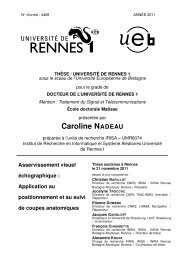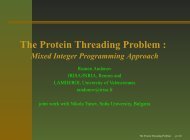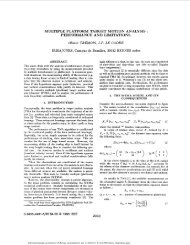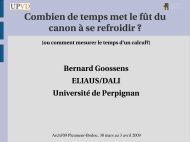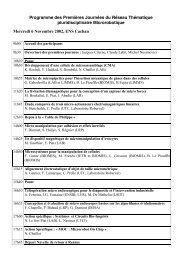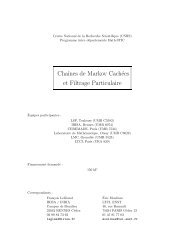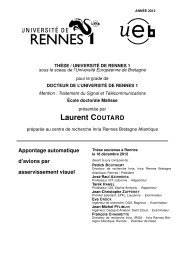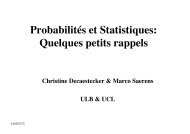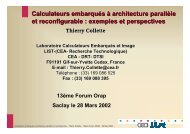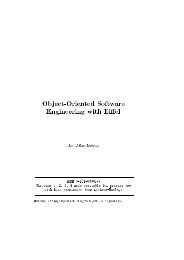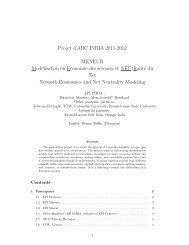Atelier Visualisation et extraction de connaissances - Irisa
Atelier Visualisation et extraction de connaissances - Irisa
Atelier Visualisation et extraction de connaissances - Irisa
Create successful ePaper yourself
Turn your PDF publications into a flip-book with our unique Google optimized e-Paper software.
CUBIST Analytics: A Visual Analysis Tool<br />
for Formal Concept Analysis<br />
Cassio Melo, Marie-Au<strong>de</strong> Aufaure<br />
MAS Laboratoire, École Centrale Paris<br />
Gran<strong>de</strong> Voie <strong>de</strong>s Vignes, 92295 Chatenay-Malabry, France<br />
{Cassio.Melo, Marie-Au<strong>de</strong>.Aufaure}@ecp.fr<br />
Abstract. This paper presents a prototype of CUBIST analytics, a Formal<br />
Concept Analysis (FCA)-based visual analytics tool for Business Intelligence.<br />
The main purpose of CUBIST analytics is to provi<strong>de</strong> novel ways of applying<br />
visual analytics in which meaningful diagrammatic representations will be<br />
used for manipulating, navigating through and visually querying complex data.<br />
We present an overview the actual prototype, current challenges and future<br />
steps towards an advanced FCA-based visual analytics tool for Business Intelligence.<br />
1 Introduction<br />
The vast amount of data generated by governments and commercial organizations over the<br />
last <strong>de</strong>ca<strong>de</strong>s has brought new challenges to the information science. There is common<br />
agreement that those data may reveal patterns in the real world very valuable to scientific<br />
experiments, aerospace industry, business applications and other data-centric applications.<br />
However, the exploitation of large amounts of data remains challenging <strong>de</strong>spite the increasing<br />
number of analysis m<strong>et</strong>hods proposed. In particular, visual analytics aims at bridging this<br />
gap by employing more intelligent means in the analysis process and is being used systematically<br />
in business applications to help managers and analysts to make b<strong>et</strong>ter <strong>de</strong>cisions.<br />
According to Keim and his colleagues (Keim <strong>et</strong> al. 2008), “visual analytics is an iterative<br />
process that involves information gathering, data preprocessing, knowledge representation,<br />
interaction and <strong>de</strong>cision making“. Visual analytics is therefore, comprised of three main<br />
axes: visualization, statistics and data mining.<br />
In or<strong>de</strong>r to analyze the relationships b<strong>et</strong>ween groups of data and their properties, we used<br />
Formal Concept Analysis (FCA) as our mainstream analytical framework. Formal Concept<br />
Analysis has become popular in early 80’s as a mathematical theory of data analysis based<br />
on the philosophical notion of a concept (Wille 1984) and since then has been applied to a<br />
vari<strong>et</strong>y of domains, to name a few, information r<strong>et</strong>rieval (Carpin<strong>et</strong>o & Romano 1995) (Priss<br />
2000); genes expression (Akand <strong>et</strong> al. 2010); machine learning (Kuzn<strong>et</strong>sov 2004). A formal<br />
concept is a tuple (E,I), containing an intent (I) and an extent (E) s<strong>et</strong>. The intent s<strong>et</strong> represents<br />
all the attributes shared by a s<strong>et</strong> of objects; conversely, the extent s<strong>et</strong> contains all the<br />
objects that have the same s<strong>et</strong> of attributes. The analytical framework provi<strong>de</strong>d by FCA is<br />
traditionally represented by a Hasse diagram with particular properties. The hierarchical<br />
structure formed by concepts can provi<strong>de</strong> reasoning for classification, clustering, implication<br />
discovery, rule learning (Akand <strong>et</strong> al.). The main problem with the traditional Hasse diagram<br />
F.Poul<strong>et</strong>, B.Le Grand : 9e <strong>Atelier</strong> <strong>Visualisation</strong> <strong>et</strong> Extraction <strong>de</strong> Connaissances 49



